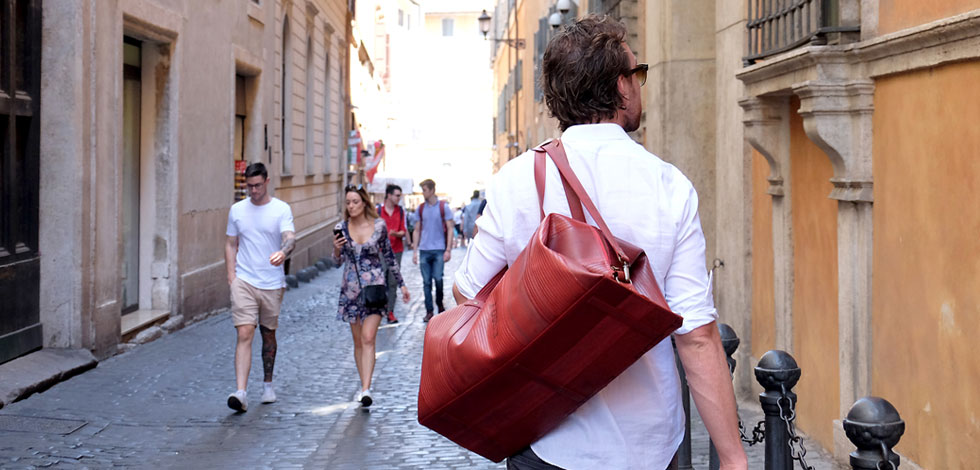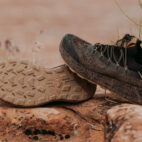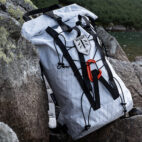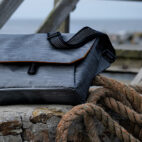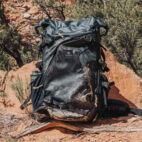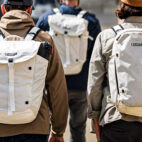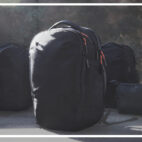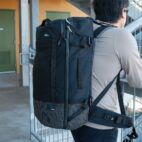Elvis & Kresse Weekender Review :: Drive By
The smell is the first thing you notice when you open up an Elvis & Kresse weekender. The sweet scent of reclaimed British fire hose – the pioneering feature of the Elvis & Kresse line – a pleasant mustiness that slowly but surely – unexpectedly – permeates your lounge room. As for the nostrils, these bags are a treat for the eyes.
Based in a 19th century water mill in bucolic Tonge a half hour from Kent in southeast UK, Elvis & Kresse find themselves at the coalface of a modern breed of carry specialists who are harnessing quality, reclaimed materials to create innovative carry solutions.
Reclamation and transformation are at the heart of Elvis & Kresse – since 2005, they’ve been scrubbing away the soot and grease from the London Fire Brigade’s decommissioned red and yellow hoses, alchemising this beautiful waste material into messengers, soft briefcases, DOPPS, overnighters, totes, bowling bags and beyond.
Who it suits
Folks lookin’ for well-made carry with character and story.
Who it doesn’t
Folks who like to blend in. You’ll stand out from the crowd when toting this.
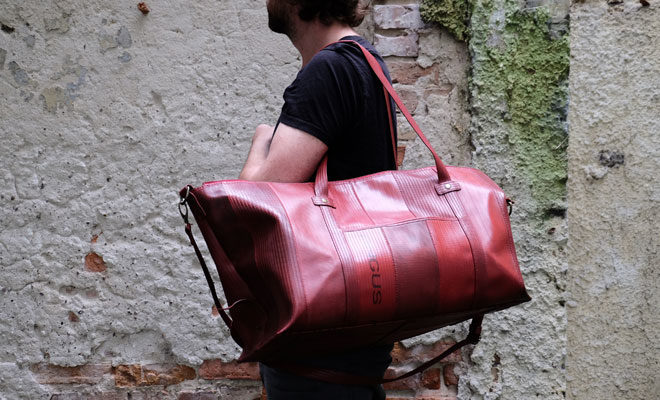
What began with hose has led to leather, coffee sacks, Air Traffic Control flight strips, and military grade parachute silk: all finding fresh lives through the transformative power of traditional British craftsmanship and an innately thoughtful green approach. In short: E & K re-incarnate the ‘unloved’ and ‘unwanted’, and they do it very, very tastefully.
All good on (recycled) paper, of course – but how exactly do such pre-loved supplies hold up aesthetically, functionally and practically? It seemed only fitting for us to take a pleasantly fragrant Elvis & Kresse weekender – fashioned with heroic, loyal hose that has never seen beyond the shores of the UK – on a trans-European field test through one of the most fashion-discerning travel regions of the world.
Destination: Italy. Cue: the Carryology-Elvis & Kresse Italian job.
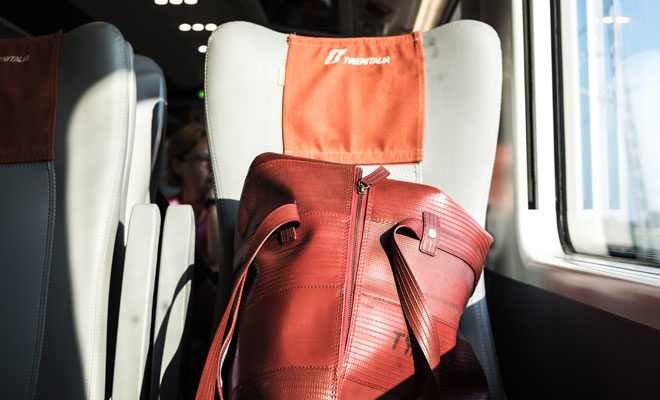
With the weekender in tow, we’d be starting slow: a night train from Berlin to Zurich; an ICE to Milan, followed by a 300km/h Frecciarossa to Rome; a regional Trenitalia to Salerno; and a ferry along the Amalfi Coast to spectacular Positano.
Though we were heading off for the better part of a week, the bag instantly proved its worth capacity-wise – unshackled by its initial form, its side ‘hold’ pins are capable of unclasping a top leather fold, the already spacious interior blossoming into a larger tote, after which it’s able to be ‘pinned’ back down into its original weekender form. Already, it was serving above and beyond its ‘run of the mill’ weekender call of duty.
An internal zip pocket and tri-section pockets on each internal wall furthered our confidence in the bag’s considerable functionality, enabling clear organisation of cords, adapters, documents and sundry accessories.
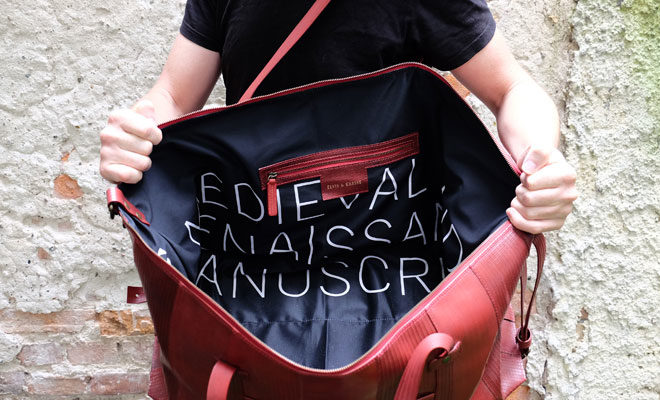
Sometimes too, it’s the features you don’t immediately see in a bag that makes all the difference to the experience. A bag’s ‘inlay’ rarely receives as much attention as its exterior features, however the luxe ‘auction banner’ lining of this weekender immediately enriched the deal – “my stuff is really comfortable in there,” I kept thinking. That the lining also featured a large ‘Sothebys’ logo only exacerbated this peculiar sense of internal satisfaction.
After an bemusing mix up on the train to Zurich via Cologne – a somewhat neurotic Deutsch Bahn employee growing increasingly neurotic at the fact we’d boarded the incorrect carriage (despite the entire wagon being virtually empty, and the actual carriage inaccessible without a potentially trip-stranding sprint three carriages further down) – we, and a couple of other conspirators who’d made the same mistake, broke for it at the quiet station of Bielefeld, narrowly re-boarding without being left behind. In the soft sweat of a balmy midnight in Cologne, we boarded a connection to Zurich, and as our carriage rocked and swayed, fell in and out of dream state in the hold of the 1970s-style berth, occasionally spying the illumined castles of Baden-Württemberg and Rhineland-Palatinate.
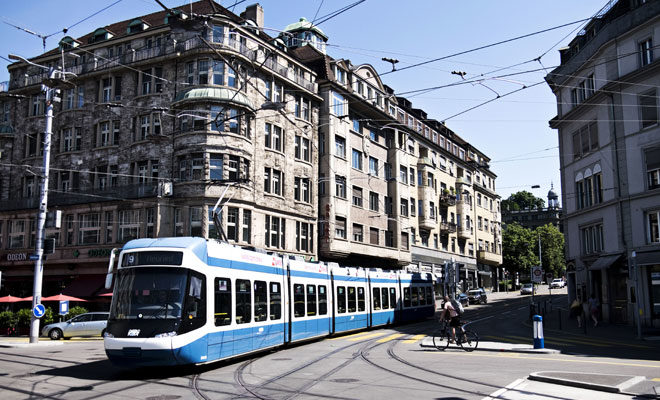
It was a surprisingly relaxing couple of days in Zurich, the fountains and city streams flowing ubiquitously through the city with some of the purest waters on the planet. We shot further south along the dramatic lake vistas of Lugano and Como, negotiating bustling Milano Stazione, before hightailing it on the express Frecciarossa to Rome.
The Elvis & Kresse, let it be known, held its own on these initial legs. It was on the train to Rome that I took stock of the bag from a visual perspective: an ultra unique sight amongst the personality-bereft rollers and canvas duffel standards stowed alongside. Sure, the hose material is raw: its rippled strips of red still carry their battle blemishes and fire wounds. But this is also what makes each individual bag so unique – ours, sporting the scrawlings ‘Type 3 10053’ on one side, and the name ‘Angus’ (which would become the bag’s nickname) on the other. In an era of desired perfection, pre-loved ‘character’ indulges a striking point of difference.
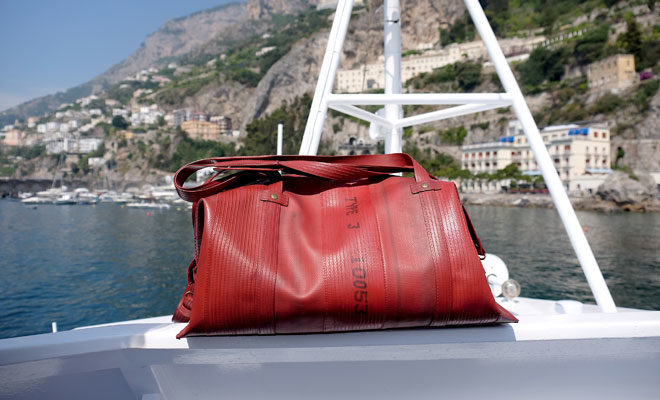
We arrived to Roma Termini as the city was finishing dinner. Marbled cobblestones and stately buildings emerged by the roadsides; umbrella pines and sultry air tinged with stone and perfume. Our next days were a flurry of sights and indulgence: the striking columns of the Pantheon, the Colosseum, sunsets over the Spanish Steps and down the labyrinthine back lanes of Rione VI Parione, where we swilled crisp Peronis in the heat of the afternoons over pizza and gelato, our multipurpose ‘Angus’ accepting day duty with acquiescent stoicism.
As the Italian sun roasted us on the ferry to Positano, amidst a boisterous public holiday crowd of locals, I somehow managed to wind up in a conversation with an electrician from Portsmouth, who appeared both miffed and deeply charmed by the Elvis & Kresse bag, and ingenuity of his native ilk.
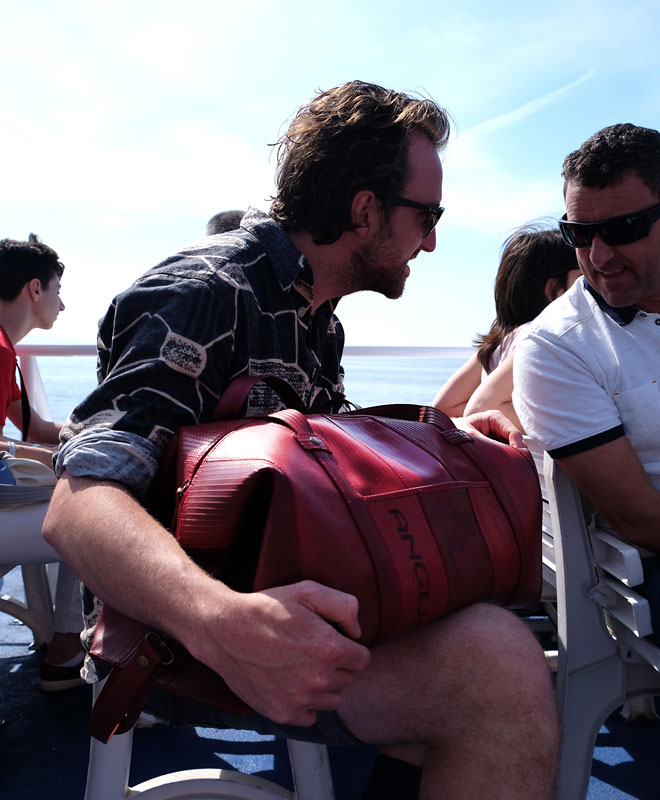
“That’s sumfin innit?” he said.
In no time, the Jurassic Park-esque peaks of the Amalfi Coast, shrouded in cloud, emerged from the rocky horizon: gravity-defying cliff-face towns of immeasurable beauty, of which Positano seemed to be the most charming of all.
Behind the beachfront and boats, the bar by the jetty, through the town’s busy, cloistered plazas, up narrow, hamstring-destroying clusters of steps, we acquainted ourselves with this transient home, drank strong, syrupy Limoncello, and to the tunes of The Talented Mr Ripley, fell for three days into a state of intoxicating Italian escapism.
Our times under pastel skies were as epic as a Gore Vidal novel. And our semi-retired, now repurposed carry chaperone not only saw the world beyond its home, but thrived in the challenge.
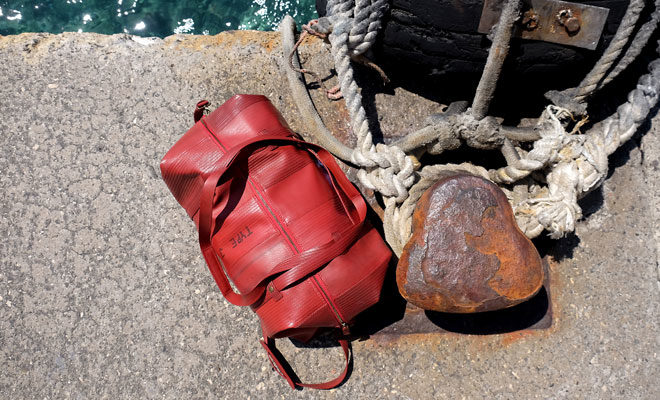
The Good
– The redeeming smell of reclaimed fire hose rubber
– The charmingly tainted look of reclaimed fire hose rubber
– Classy interior material
– Unusually spacious hold for a weekender
– The impressive sustainable ethic
– Free repairs
– 50% of each Elvis & Kresse sale goes to charity
– One year guarantee
The Not So Good
– Straps a little light on
– Rough and ready vibe might not do it for some
– It’s expensive at $US400.00
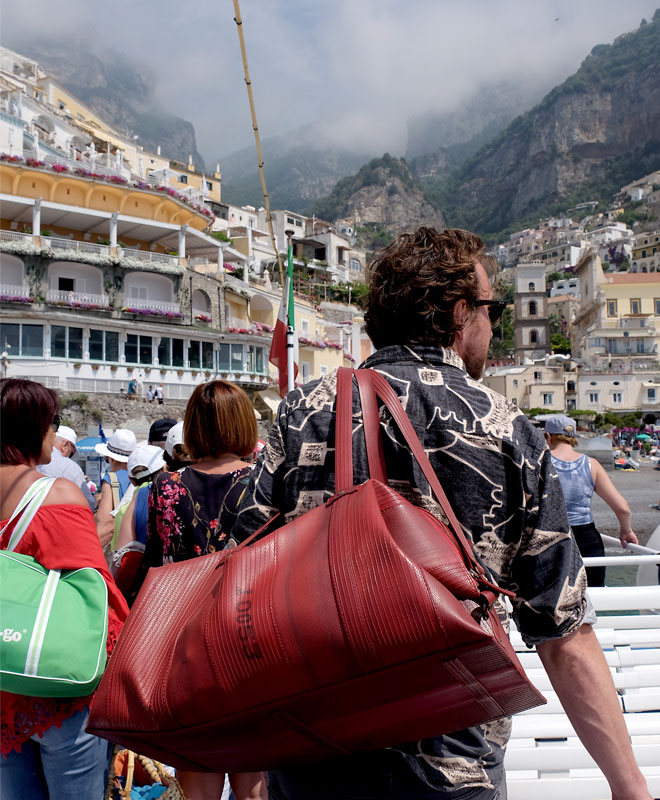
Verdict
We established that this bag looks (and smells) awesome. The aesthetics – as unusual as they are – get a solid tick for uniqueness and innovation. Those ticks continue where functionality is concerned. This is an elegantly simple bag construction-wise. The malleable shape is a real bonus and helps fit the sort of gear that another weekender might fail to – that, in tandem with its trio of external straps means that this weekender can effortlessly transform – into a spacious shopping tote or laundry bag, for example.
In its chief job description, though – a weekender – it thrives. Though its rubber straps may not be the most reinforced – which means there’s an upper limit on what you can get away with lugging around – it dishes up the three R’s: resilient, reliable and robust. The fire hose seems thrilled and humbled with its career change. The fact that the material has already endured 25 years worth of hard knocks means you can’t really do much damage to these bags either. That 50% of each Elvis & Kresse sale goes to charity only furthers the conviction: this is an inherently good organisation with a conscience that makes practical, innovative bags like no one else in the world.
Photography by Honor Kennedy.





 Carry Awards
Carry Awards Insights
Insights Liking
Liking Projects
Projects Interviews
Interviews
